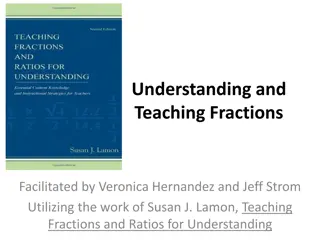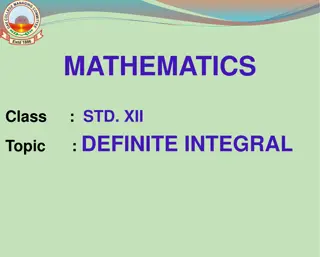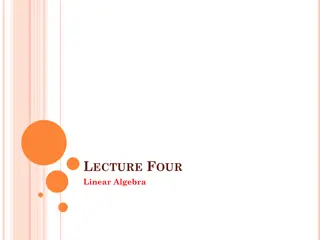Concrete Mix Design: Optimal Proportions & Aggregate Gradation
Concrete mix design is crucial for achieving the desired properties and performance of concrete. The Maximum Aggregate Density Mix Design method helps determine the best proportions for Portland Cement Concrete. Utilizing combined aggregate gradation near the maximum density line can reduce shrinkag
0 views • 34 slides
Understanding Proportions and Confidence Intervals in Statistics
Explore the concept of proportions in statistics, where the parameter of interest is the percentage of a population with a specific characteristic. Learn how confidence intervals help us assess the reliability of our estimates and how to calculate them using sample statistics. Discover the importanc
0 views • 18 slides
Understanding Accumulation Problems and Definite Integrals in Applied Calculus
Explore the interpretation of definite integrals in accumulation problems, where rates of change are accumulated over time. Learn how to solve accumulation problems using definite integrals and avoid common mistakes by understanding when to use initial conditions. Discover the relation between deriv
0 views • 9 slides
Understanding the Production Function and Laws of Production
Production function expresses the relationship between inputs and outputs, showcasing how much can be produced with a given amount of inputs. The laws of production explain ways to increase production levels, including returns to factors, law of variable proportions, and returns to scale. The law of
2 views • 20 slides
Understanding Percent Composition and Empirical Formulas in Chemistry
The Law of Definite Proportions governs the composition of compounds based on molar masses, allowing us to calculate percentage compositions of elements within a compound. Through examples involving various compounds like Fe3C, sulfur dioxide, ammonium nitrate, glucose, and acetic acid, we explore t
3 views • 7 slides
Understanding Proportions in Mathematics
Explore the concept of proportions in mathematics as you learn to define proportions, determine their accuracy, find unknown values, and solve problems using proportions. Key vocabulary such as ratio, proportion, cross multiplication, equality, and fractions are covered in this lesson. Practice iden
0 views • 21 slides
How to Calculate the Proportions for C10 Concrete?
Learn how to calculate the correct proportions for mixing C10 concrete. Get the right mix for your construction projects with these simple steps.\n
1 views • 6 slides
Exploring Ratios and Proportions in an Engaging Learning Session
Dive into a dynamic learning experience focused on ratios, proportions, and pattern recognition. Engage in counting activities, memory tests, and visual challenges to strengthen your understanding of mathematical concepts. Uncover the significance of clear instructions and effective strategies in en
0 views • 37 slides
Understanding Proportions in Physics
Exploring the concept of proportions in physics, specifically how to determine the mass of an object using the formula F = ma. Discover the relationship between force, mass, and acceleration in solving problems related to net force calculations.
0 views • 34 slides
Understanding the Uses of Definite Articles in English Grammar
Explore the various rules and applications of definite articles in English grammar through this lesson. From identifying when to use "the" before rivers and mountains to unique objects and historical places, this comprehensive guide will enhance your understanding of definite articles.
0 views • 11 slides
Overview of UK Law: Statute Law, Common Law, Criminal Law, Civil Law
Statute Law is written law created through the parliamentary process, forming the basis of the legal system. Common Law, on the other hand, is unwritten law based on judicial decisions and precedents. They govern different aspects such as civil and criminal matters, each with its unique characterist
0 views • 15 slides
Mastering Fractional and Proportional Reasoning Workshop
Dive into the world of fractions and proportions in this workshop facilitated by Veronica Hernandez and Jeff Strom, based on the work of Susan J. Lamon. Explore critical components like units, equivalence, comparison techniques, and fraction sense, without relying on traditional rules. Embrace reaso
0 views • 40 slides
Math Practice: Ratios, Proportions, Estimation, and Geometric Figures
Explore math concepts such as ratios, proportions, estimation, rounding, and geometric figures through engaging lessons and problem-solving scenarios. Practice using proportions to find missing values, round whole numbers and decimals, estimate costs, and learn about geometric shapes. Enhance your m
0 views • 19 slides
Understanding Ratios and Proportions in Mathematics
Ratios are a fundamental concept in mathematics that compare the sizes of different quantities. This content explains how to find ratios between quantities, simplify ratios, and work with ratios expressed in different units or containing decimals. Understanding ratios and proportions is crucial for
0 views • 25 slides
Understanding Sampling Methods in Business Analytics
Sampling plays a crucial role in estimating proportions and making informed decisions in business analytics. From polling to estimating proportions, this class explores sampling techniques, sample size determination, and potential biases. Learn about choosing a sample size, stratified and cluster sa
2 views • 23 slides
Understanding Categorical Data Analysis for Proportion Estimation
In the realm of categorical data analysis, estimating proportions is crucial for understanding population characteristics. This involves sampling, calculating sample proportions, standard errors, and constructing confidence intervals. Through examples like studying the effects of treatments on medic
0 views • 72 slides
Categorical Data Analysis in Population Studies
Inference methods for estimating proportions in a population are essential in categorical data analysis. This includes techniques for single proportions, confidence intervals, sample size determination, and Wilson-Agresti-Coull method for small sample sizes. Illustrated with examples and visuals, th
0 views • 80 slides
Basics of Spanish Nouns and Articles
This lesson introduces the fundamental concepts of gender, number, and articles in the Spanish language. Students will learn about the gender and number of words, definite and indefinite articles, as well as rules for forming the feminine of nouns. The chapter covers the usage of definite articles i
0 views • 7 slides
Understanding Ratios, Rates, and Proportions
Explore the concepts of ratios, rates, and proportions through simple examples and explanations. Learn how to express ratios as fractions in their simplest form and understand the relationship between different quantities. Discover how to compare quantities with the same units and represent ratios u
0 views • 24 slides
Applications of Definite Integrals in Finding Areas
Explore the practical applications of definite integrals through the concept of finding areas. These images illustrate how definite integrals are used to calculate areas bounded by curves and lines, offering a visual representation of the integral calculus in action.
0 views • 9 slides
Understanding the Fundamental Theorem of Calculus
Explore the connection between differential calculus and the definite integral through the fundamental theorem of calculus, which allows for the evaluation of complex summations. Discover the properties of definite integrals and how to apply the theorem to find areas under curves. Practice evaluatin
0 views • 15 slides
Understanding Definite Integrals in Calculus
Explore the concept of definite integrals in calculus, including their new symbol definition, area interpretation, and examples of evaluating integrals in terms of areas. Learn about the limits of integration, the procedure of integration, and how definite integrals can represent areas under curves.
0 views • 34 slides
Definite Integrals Using Graphing Display Calculator for Evaluation
Learn how to use a Graphing Display Calculator (GDC) to evaluate definite integrals step-by-step. Follow the instructions provided in the images to input the function and calculate the result with the GDC. This interactive process helps in understanding how technology can assist in mathematical comp
0 views • 17 slides
Understanding Definite Integrals in Mathematics
Explore the concept of definite integrals in mathematics, covering properties, solving methods, and applications in finding areas bounded by curves. Prior knowledge of functions, limits, derivatives, and indefinite integrals is essential to grasp this topic effectively. Dive into the unique value of
0 views • 32 slides
Talking About Definite Plans in Academic Context: Mechanical Engineering Course with Professor Leticia Sánchez Franco (Jan-Jun 2015)
When a future plan is detailed with a set date, place, and time, it becomes a definite plan. In this academic context of Mechanical Engineering with Professor Leticia Sánchez Franco, the usage of present continuous language structure to express definite plans is highlighted through examples and con
0 views • 8 slides
Understanding Definite Integration in Mathematics
Delve into the concept of definite integration in mathematics with a focus on finding areas under curves, evaluating definite integrals, and solving exercises that involve calculating areas between curves and the x-axis. Explore the principles and techniques behind finding total areas between specif
0 views • 22 slides
Understanding Linear Algebra Concepts: Systems of Equations, Orthogonal Matrix, and Quadratic Forms
Explore the concepts of simultaneous linear equations, homogeneous and non-homogeneous systems, orthogonal matrices, and various types of quadratic forms in linear algebra. Learn about the characteristics of positive definite, semi-positive definite, and negative definite quadratic forms represented
0 views • 7 slides
Understanding Definite Articles in English and Spanish
Discover the use of definite articles in English and Spanish with this comprehensive guide. Learn how to apply definite articles before nouns, whether they are masculine, feminine, singular, or plural. Explore the nuances of using definite articles in different contexts and enhance your language ski
0 views • 103 slides
Proportions in Capture-Recapture Method for Estimating Fish Population
Explore the capture-recapture method to estimate the total fish population in a habitat. Learn how to select and tag fish, replace goldfish with tagged fish, count and calculate proportions to determine population estimates. Repeat the procedure for accuracy and compare calculated estimates with the
0 views • 11 slides
Circles: Formulas for Circumference, Area, and Proportions for Arc Length and Sector Area
Learn how to calculate the circumference and area of circles using formulas, and use proportions to find arc length and sector area. Master the concepts through examples and practical applications in geometry.
0 views • 18 slides
Study of Definite Article and Prepositions in Biblical Hebrew
Explore the identification and reading of the definite article with prepositions, Qal qatal and Piel qatal paradigms, and various questions related to Hebrew grammar. Understand the significance of prepositions with the definite article and learn about verb charts for qatal forms in Biblical Hebrew.
0 views • 25 slides
Understanding Ratios, Rates, and Proportions
Learn about ratios, rates, and proportions - comparing numbers and measures, simplifying ratios, finding unit rates, and making cost comparisons. Dive into examples and visual explanations to enhance your understanding of these mathematical concepts.
0 views • 10 slides
Solving Ratios and Proportions - Math Practice and Problem Solving
Practice solving ratios and proportions with various scenarios including sharing money, making pastry, mixing paints, and calculating dimensions. Work on determining quantities, numbers of students, and perimeters based on given ratios. Improve your math skills with practical application exercises.
0 views • 6 slides
Understanding Ratios and Proportions in Geometry
Explore the concept of ratios and proportions in geometry, focusing on how they are used to solve problems and prove relationships in geometric figures. Learn about properties of proportions, similarity criteria for triangles, and the importance of identifying and applying similar polygons. Discover
0 views • 16 slides
Exploring Ratios and Proportions in Year 9 Mathematics
Dive into the world of ratios and proportions with Dr. J. Frost's engaging exercises and puzzles for Year 9 students. Explore concepts such as direct proportion, unitary method, and solve problems involving fish tanks, polygons, and more. Strengthen your understanding of mathematical relationships t
0 views • 11 slides
Fun with Ratios and Proportions in Everyday Situations
Explore the world of ratios and proportions through engaging scenarios like feeding seals, playing games, and mixing paint. Solve fun problems involving ratios and proportions to enhance your math skills and logical thinking abilities.
0 views • 16 slides
Proportional Portrait Drawing Tutorial
In this tutorial, learn how to create a portrait with accurate proportions. Follow step-by-step instructions on facial proportions to draw a face correctly. Practice observation skills and explore portrait conventions. The slides provide visual guidance for drawing the head shape, positioning facial
0 views • 17 slides
Overview of Legal Systems and Roman Law Development
Legal systems play a crucial role in governing societies, with Roman Law, Common Law, Civil Law, and Religious Law being some of the major types worldwide. Roman Law, focusing on private law, has influenced legal traditions in various regions, especially in Europe. Contrasting Common Law and Civil L
0 views • 26 slides
3D Display Methods in Computer Graphics: Parallel vs Perspective Projection
3D computer graphics utilize a three-dimensional representation for rendering images. This article discusses parallel and perspective projection methods, highlighting their differences in preserving proportions and creating realistic views. Parallel projection maintains relative proportions, while p
0 views • 14 slides
Understanding Ratios and Proportions in Chapter 7
Explore the concept of ratios and proportions in Chapter 7, focusing on writing ratios, solving proportions, and understanding extremes and means. Additional examples and practical applications are provided to enhance learning. Discover how to write equivalent proportions and solve real-world proble
0 views • 9 slides







































